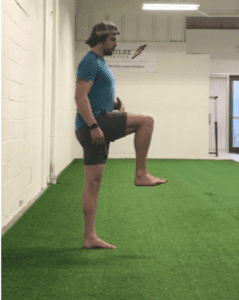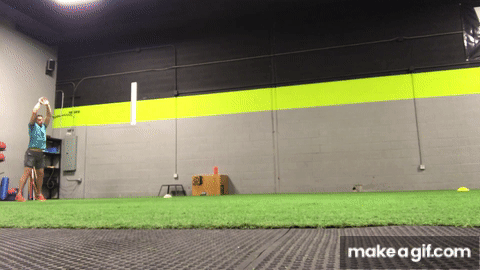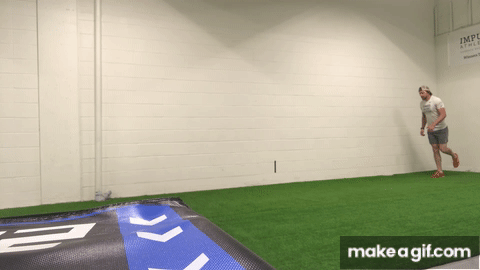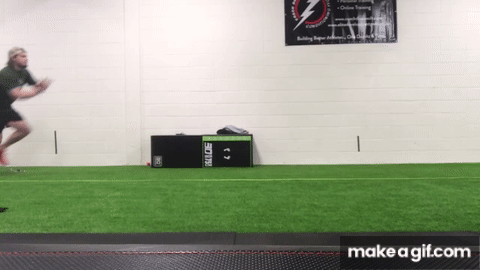Speed Training Drills For Every Athlete

Kyle Donsberger is a CSCS, lifelong athlete, and owner of Impulse Athletics. As a current member of the Canadian Skeleton Team and 2012 & 2016 Olympic Trials semi-finalist in the 400 meters, he knows a thing or two about speed training. Continue reading for his top tips on developing explosive speed and sprinting mechanics.

What Is Speed Training?
So, what should you focus on when it comes to speed training? Speed is multidimensional and requires technical abilities, power development, strength, and neural drive. Let’s go through three different aspects of speed training in more depth.
Acceleration Mechanics
Acceleration mechanics impact your ability to generate initial speed. When looking at acceleration, there are a few things you want to work on:
1. Driving your foot under your body, not in front of you. When your foot drives directly under you, there’s less contact time on the ground. It also increases your ability to drive forward.
2. Stabilizing your upper body so that you can transfer forces from your arms down through the ground to be more explosive. We also need to make sure that the arms are traveling in straight lines (not twisting) to maximize power production.
Power Development
The more power you can generate, the faster you can move. In physics, power is the amount of energy transferred or converted per unit of time. To develop power for speed, you need to develop large amounts of muscular force over shorter periods of time.
Strength
Studies show that relative strength is a key indicator of speed. The sweet spot for relative strength is the ability to squat 2-2.5x bodyweight.
Having this level of strength allows you to generate enough force to keep your body upright while sprinting. This allows you to develop force quickly.
Sprinting
The last and most important thing about speed training is that you need to actually run at full speed to work on the skill. So after developing all these skills, we need to implement them into speed training by just sprinting as fast as we can.
Change the Way You Train
4 Progressive Drills for Acceleration
1. Bucket Hold
Let’s start with one of the most basic exercises to work on speed training: the bucket hold. The point of this exercise is to become comfortable being in a strong, tall position, which is key for full speed.
Stand tall and use your hip flexor to lift your knee up. Make sure the foot is directly under your knee, not under your butt (this affects your mechanics). Drive through your grounded leg and extend up as tall as you can.
To progress, hold a stick over your head, which forces you to stay tall. You can also add load to challenge your stability by holding a med ball, kettlebell, or an aqua bag instead.

2. Switches
After you’ve mastered the bucket hold, you can progress to switches. In this movement, you are aggressively switching legs while maintaining posture and stability.
It’s important that you’re snapping your legs down, not jumping to drive your knee up. Focus on driving the “up” leg into the ground and switching with the other knee. Like bucket holds, you can add complexity by holding a stick over your head or adding load.

3. Wall Drill
The wall drill improves acceleration mechanics, which is crucial for developing speed.
Put your hands on the wall and lean forward with your ankles. Your lean should be anywhere from 60-45 degrees (the deeper the lean, the better). From here, bring one knee forward in a controlled manner while keeping your hips square and the grounded foot strong.
Ideally, your shoulders and hips are in line during this movement. Bring your knee up to about 90 degrees, then bring it back down to the starting position. As you become more comfortable, you can add speed to the movement, eventually getting up to full speed.

4. Dead Legs
Dead legs are the bread and butter for acceleration mechanics. In this one, you’re sticking to one side and not alternating like you would for A-skips. “Bounce” with a nice rhythm and explosively drive your knee up to about a 90-degree angle. Once it hits that 90 degrees, drive it back down as fast as you can.
Like with switches, the key is driving your leg down. With practice, you’ll be able to apply force into the ground more quickly.

3 Drills for Explosive Power
1. Double Leg Hop / Standing Broad Jump
This drill is key to developing explosive power for your start.
Focus on loading through your hips and exploding forward as far as you can. Land in an athletic position (stable on both feet with no twisting of the hips) as best you can. The idea is to challenge the angle of take-off so you’re producing maximal horizontal force.
The key is keeping a stable upper body, which makes it easier to transfer power from your arms and through the legs.

2. Single Leg Hop
This one is like the double-leg hop, except you’re only using one leg. Remember to keep a stable upper body and land in an athletic position (no hip twisting!). This is a great drill to challenge your dynamic balance.

3. Bounding
Bounds focus on horizontal and vertical force production. Hop from one leg to the other, trying to cover as much distance and get as much air as possible with each hop.
Make sure your foot is landing under your center of mass. This propels you forward with the next jump.

Master Your Start
Start in a 2-point stance. Focus on loading up the front leg and exploding forwards.
The key to loading up your front leg is to sit into your hips so your weight shifts onto the front leg. Drive your hips down and feel a load through the hamstrings similar to stretching an elastic band before firing it. Focus on driving as far forward as you can – this will generate the best angle to develop acceleration.
To build speed, keep your back flat and gradually get taller with each step. By about step five or six, you should be upright. The faster you can get upright while driving forward, the faster you are able to move.
Coach’s Tip: For an in-depth guide on how to master your start, check out The Secret to Sprinting Faster: Work on Your Start.
Tie It All Together
If you want to improve your acceleration and speed, I recommend speed training a minimum of twice per week. If you don’t have a whole bunch of time to do a speed workout, then think about microdosing it. Do 10 minutes of sprint work/drills at the end or beginning of a workout. Those minutes add up and can lead to big changes if done consistently!
Say you train four times a week. Adding 10 minutes of speed work during each of those workouts will get you 40 mins of speed work in a week! In a month, you’ll get 160 mins of speed work. (Nearly 3 hours!)
No matter your fitness goals, everyone can benefit from speed work. Being able to run fast with good form and footing is important for so many sports (including chasing your kiddos around the yard). If you dial in these 7 drills and include a little sprint work, you’ll see yourself transform into a completely different animal!
Find Your Perfect Training Plan
Sometimes all you need to reach your destination on your fitness journey is an expert guide. We've got you covered. Browse from thousands of programs for any goal and every type of athlete.
Try any programming subscription free for 7 days!
Want Training Tips, Exercise Guides & Knowledge Bombs Sent to Your Inbox?
Sign up for the FitNerd newsletter from TrainHeroic
Related articles
3 Ways to Improve Mobility Without Stretching
Are you still trying the endless foam rolling and stretching exercises to get that deep squat position? We know how important mobility is for great, or even GOOD performance. All professional athletes have some comfortability in end ranges of motion. So, what else do...
The Ultimate Guide to Lunges: Queen of all Glute Exercises
Your glutes are the largest muscle group in your body. They’re responsible for almost everything your legs do—walking, running, jumping, squatting, lunging, and just standing upright. As far as moving through space goes, strong glutes are the bedrock of overall...
A Beginner’s Guide to Steel Mace Training
Author: Jesse Grund
Mace training will make you a better mover without it’s not confining you to a fixed space or predetermined range of motion. Second, it’s an offset load with 80 to 90 percent of the weight in the head. You’re also constantly having to resist rotation, which creates greater core engagement.

Join the community
Sign up for the latest training news and updates from TrainHeroic

About TrainHeroic
Made with love, sweat, protein isolate and hard work in Denver, CO
© 2023 TrainHeroic, Inc. All rights reserved.







